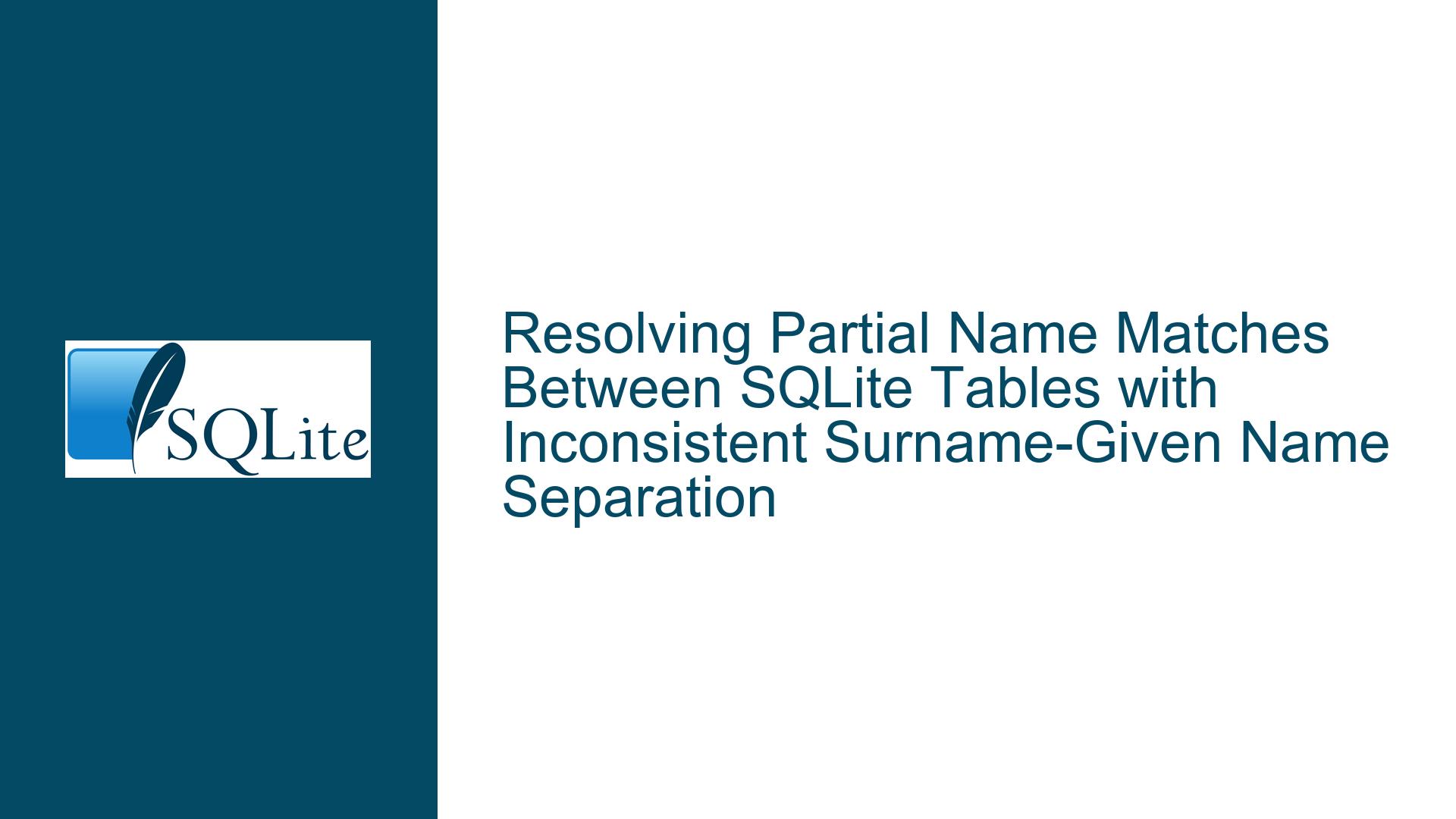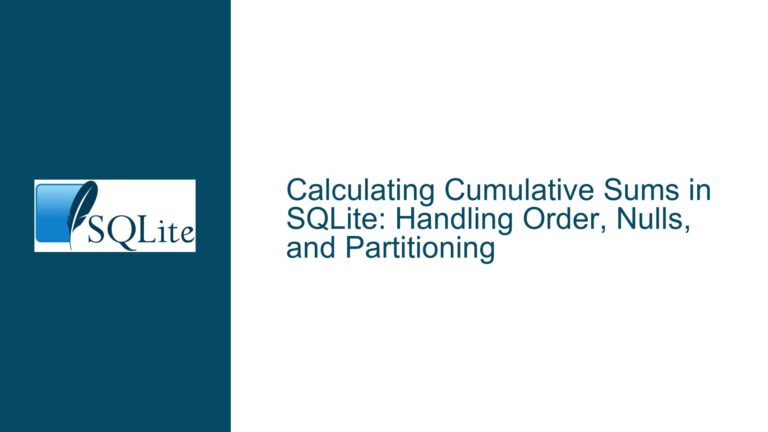Resolving Partial Name Matches Between SQLite Tables with Inconsistent Surname-Given Name Separation
Core Challenge: Ambiguous Name Segmentation and Cross-Table Matching
Structural Obstacles in Name Data Normalization
The problem revolves around matching records across two SQLite tables containing names with inconsistent separation of surnames and given names. The data originates from a governmental source with variable data entry practices, leading to ambiguous splits between surname and given name components. For example:
- "Ellis Ross Tracey" (interpreted as surname "Ellis Ross", given name "Tracey")
- "Badger Tracey" (interpreted as surname "Badger", given name "Tracey")
The goal is to identify records where the given names align across tables but surnames differ. The primary obstacle is the lack of standardized parsing logic for names, compounded by cultural variations in naming conventions and inconsistent data entry practices. Hyphenated surnames, multi-word given names, and initials further complicate the matching process.
Key complexities include:
- Variable Tokenization: Names are split into surname/given name components inconsistently (e.g., "Wentworth Fitzwilliam de Chair Helena Anne Beatrix" vs. "Rees-Mogg Helena Anne Beatrix").
- Cultural Heterogeneity: Names follow conventions from 18+ ethnic groups, with differing rules for surname/given name order.
- Dynamic Data Updates: Monthly updates introduce incremental changes, but only 2% of records are updated annually, creating a mix of legacy and new formatting styles.
- Ambiguous Lexemes: Terms like "Gordon" or "Sian" can function as surnames or given names depending on context.
Root Causes of Matching Failures
- Unstructured Name Storage: Names are stored as combined strings without programmatic normalization, relying on error-prone manual separation.
- Inconsistent Data Entry Practices: Clerks use ad-hoc rules to split surnames and given names, leading to mismatched components across records.
- Lack of Cultural Context in Parsing: Automated systems fail to account for surname-first naming conventions in certain cultures (e.g., East Asian names).
- Overloading of Initials and Hyphens: Initials (e.g., "Rachel M") and hyphenated surnames (e.g., "Richardson-Whitefield") are treated inconsistently during data entry.
- Absence of Validation Rules: No checks enforce uniformity in surname/given name assignment, allowing errors to propagate across updates.
Strategic Solutions and Technical Implementation
Step 1: Name Component Standardization
Use SQLite string functions to programmatically split full names into surname and given name components. Assume the given name is the last token unless initials are present:
WITH NormalizedTable1 AS (
SELECT
CASE
WHEN INSTR(TRIM(name), ' ') = 0 THEN ''
ELSE SUBSTR(name, 1, LENGTH(name) - INSTR(REVERSE(name), ' '))
END AS surname,
SUBSTR(name, LENGTH(name) - INSTR(REVERSE(name), ' ') + 2) AS given_name
FROM table1
),
NormalizedTable2 AS (
SELECT
CASE
WHEN INSTR(TRIM(name), ' ') = 0 THEN ''
ELSE SUBSTR(name, 1, LENGTH(name) - INSTR(REVERSE(name), ' '))
END AS surname,
SUBSTR(name, LENGTH(name) - INSTR(REVERSE(name), ' ') + 2) AS given_name
FROM table2
)
This logic uses REVERSE to locate the last space, splitting the string into surname (all tokens before the last space) and given name (last token). It handles multi-word surnames like "Fitzwilliam de Chair" and single-word surnames like "Badger".
Step 2: Initials Handling
Strip initials from given names to avoid mismatches like "Rachel M" vs. "Rachel":
SELECT
surname,
REPLACE(REPLACE(given_name, '.', ''), ' ', '') AS cleaned_given_name
FROM NormalizedTable1;
This removes periods and spaces from initials, converting "Rachel M" to "RachelM". Apply this to both tables before matching.
Step 3: Cultural Naming Convention Adjustment
For cultures where surnames precede given names (e.g., Chinese, Korean), use external metadata to invert the order:
SELECT
CASE WHEN is_surname_first THEN given_name ELSE surname END AS surname,
CASE WHEN is_surname_first THEN surname ELSE given_name END AS given_name
FROM NormalizedTable1
JOIN CulturalMetadata ON ...;
This requires a lookup table (CulturalMetadata) identifying records needing inversion, populated via external research or machine learning.
Step 4: Fuzzy Matching with Edit Distance
Use the editdist3 SQLite extension to handle typos and near-matches in given names:
SELECT a.surname, a.given_name, b.surname, b.given_name
FROM NormalizedTable1 a
JOIN NormalizedTable2 b
ON editdist3(a.cleaned_given_name, b.cleaned_given_name) < 3
AND a.surname != b.surname;
This allows a tolerance of up to 2 character edits (e.g., "Helena" vs. "Helene").
Step 5: Hyphenated Surname Reconciliation
Treat hyphenated surnames as single units to avoid partial matches:
SELECT
REPLACE(surname, '-', '') AS unified_surname,
given_name
FROM NormalizedTable1;
Apply this to both tables, enabling "Rees-Mogg" to match "ReesMogg" if present.
Step 6: Cross-Table Join with Exclusion
Combine the above steps into a final query that excludes exact surname matches:
SELECT
a.surname AS surname1,
a.given_name AS given_name1,
b.surname AS surname2,
b.given_name AS given_name2
FROM
(SELECT REPLACE(surname, '-', '') AS surname, cleaned_given_name FROM NormalizedTable1) a
JOIN
(SELECT REPLACE(surname, '-', '') AS surname, cleaned_given_name FROM NormalizedTable2) b
ON a.cleaned_given_name = b.cleaned_given_name
AND a.surname != b.surname;
Step 7: Performance Optimization
Create indexed views for normalized names to speed up joins:
CREATE VIEW IF NOT EXISTS v_normalized_table1 AS
SELECT
REPLACE(
CASE
WHEN INSTR(TRIM(name), ' ') = 0 THEN ''
ELSE SUBSTR(name, 1, LENGTH(name) - INSTR(REVERSE(name), ' '))
END, '-', ''
) AS surname,
REPLACE(REPLACE(
SUBSTR(name, LENGTH(name) - INSTR(REVERSE(name), ' ') + 2),
'.', ''), ' ', '') AS cleaned_given_name
FROM table1;
CREATE INDEX idx_normalized_given ON v_normalized_table1(cleaned_given_name);
Repeat for table2, then execute the join on indexed columns.
Step 8: Validation with Manual Sampling
Extract a random sample of matched records for manual verification:
SELECT * FROM (
SELECT
a.surname AS surname1,
a.cleaned_given_name AS given1,
b.surname AS surname2,
b.cleaned_given_name AS given2
FROM v_normalized_table1 a
JOIN v_normalized_table2 b
ON a.cleaned_given_name = b.cleaned_given_name
AND a.surname != b.surname
ORDER BY RANDOM()
) LIMIT 100;
Adjust matching logic based on error patterns observed in the sample.
Step 9: Incremental Update Handling
For monthly updates, stage new records in a temporary table, normalize them using the same logic, then merge into main tables:
-- Normalize new batch
CREATE TEMP TABLE temp_updates_normalized AS
SELECT ... [same normalization logic] ...;
-- Merge with existing data
INSERT INTO table1
SELECT * FROM temp_updates_normalized
WHERE NOT EXISTS (
SELECT 1 FROM table1
WHERE surname = temp_updates_normalized.surname
AND given_name = temp_updates_normalized.given_name
);
Step 10: Long-Term Data Quality Monitoring
Implement a trigger to flag records deviating from expected patterns:
CREATE TRIGGER validate_name_format
AFTER INSERT ON table1
BEGIN
INSERT INTO name_quality_issues (record_id, issue)
SELECT
NEW.id,
CASE
WHEN NEW.given_name GLOB '*[0-9]*' THEN 'Numeric character in given name'
WHEN LENGTH(NEW.surname) - LENGTH(REPLACE(NEW.surname, ' ', '')) > 3 THEN 'Excessive surname tokens'
ELSE NULL
END
WHERE issue IS NOT NULL;
END;
Review flagged records periodically to refine normalization rules.
Final Query Synthesis
Combining all steps, the comprehensive solution involves:
- Normalizing names via surname/given name splitting.
- Cleansing initials and hyphens.
- Applying cultural adjustments.
- Joining on cleaned given names while excluding surname matches.
- Validating with manual checks and automated quality triggers.
This approach balances computational efficiency with tolerance for real-world data inconsistencies, enabling accurate identification of records with matching given names and divergent surnames across tables.






